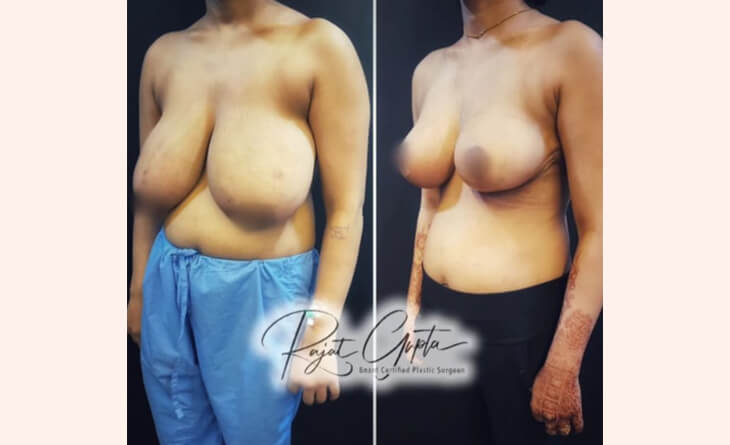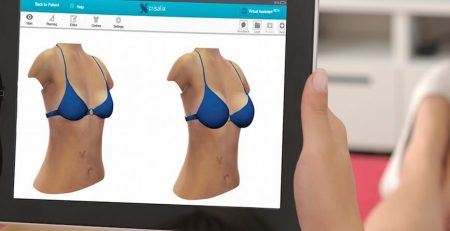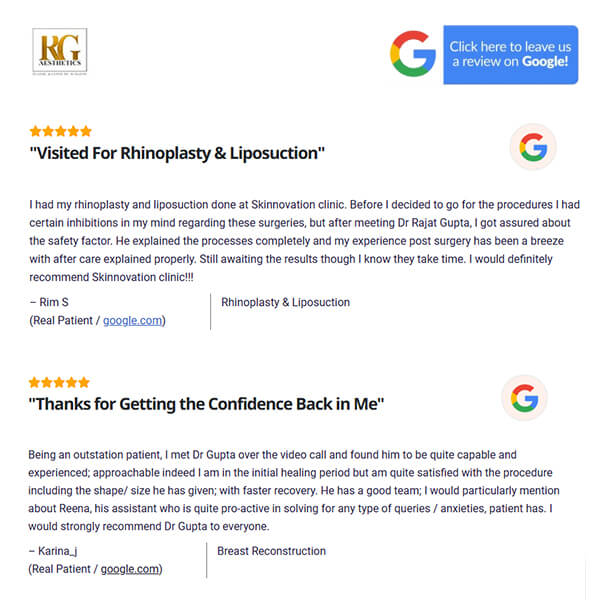Exploring Your Choices for Cosmetic Breast Reshaping
Breast reshaping surgery helps to enhance the appearance of the breast by correcting its form or appearance through various procedures, including breast augmentation surgery, breast reduction, or lift. Women may seek breast reshaping for multiple reasons, such as enhancing size and shape for a more proportionate figure, correcting asymmetries, lifting sagging breasts due to aging or after childbirth, reducing discomfort from overly large breasts, or reconstructing the breast following a mastectomy.
Types of Cosmetic Breast Reshaping Surgeries
Here are several types of cosmetic breast surgeries:
Breast Augmentation Surgery: Breast augmentation helps to increase breast size and enhance breast shape. This is typically achieved through the insertion of implants or fat grafting. There are different types of implants:
- Silicone Gel Implants: Filled with silicone gel, these implants feel more like natural breast tissue. They’re preferred for their realistic texture and shape.
- Saline Implants: These implants are filled with sterile salt water. They’re inserted empty and filled once in place, allowing for adjustable size during surgery.
- Structured Saline Implants: A variant of saline implants, they contain an inner structure to make them feel more natural than traditional saline options.
- Cohesive Gel Silicone Implants (“Gummy Bear” Implants): These have a thicker, more cohesive silicone gel, maintaining their shape even if the implant shell breaks.
The procedure involves making incisions either along the areolar edge (peri-areolar incision), the fold under the breast (inframammary fold) or in the armpit (axillary incision). The implant and incision site choice depends on several factors, including your anatomy, the desired outcome, and your surgeon’s recommendation.

Have questions or want to get started? We are ready to help you with a smile!
Fat Grafting: Autologous fat grafting to the breast, a technique gaining popularity for its natural approach and less invasive nature than traditional breast implants. This technique involves harvesting the patient’s own fat from areas with excess fat like the stomach and thighs, through liposuction and then injecting it into the breasts for effective enhancement. This method gives a more natural look and feels, using the body’s own fat avoiding synthetic materials. Additionally, it presents a dual cosmetic advantage by not only enlarging the breasts but also sculpting the body where the fat was removed, addressing two aesthetic desires with a single procedure. Moreover, the fat transfer results are generally long-lasting, with the integrated fat offering permanent benefits. This option stands out for those seeking breast enhancement without the use of implants, favouring a minimally invasive method that complements the body’s natural contours.
Breast Reduction Surgery: Beneficial for those experiencing physical discomfort or self-consciousness due to large breasts, breast reduction surgery removes excess breast tissue and skin. Surgical techniques vary, aiming to achieve a breast size in proportion with the body, alleviating symptoms like back pain.
The surgery involves the removal of excess breast fat, glandular tissue, and skin to achieve a breast size in proportion with the body. Incision patterns and techniques vary based on the desired amount of reduction.
You may feel swelling and pain after surgery, which may be managed with prescribed medicines. Recovery often takes a few weeks, and patients are recommended to reduce physical activity. Changes in breast or nipple feeling and scarring are also potential risks.
Breast Lift (Mastopexy) Surgery: A breast lift addresses sagging by removing excess skin and tightening the surrounding tissue. This procedure elevates the breasts to a more youthful position without significantly altering their size. It is an ideal choice for those with drooping breasts due to aging, weight loss, or childbirth.
This procedure involves removing excess skin and tightening the surrounding tissue to reshape and support the new breast contour. The nipple and areola may be repositioned or resized to complement the new breast shape.
Breast Reconstruction Surgery: Post-mastectomy or injury, breast reconstruction offers several options to restore the breast’s appearance. Some procedures include reconstruction or using the patient’s tissue (flap reconstruction), customized to the individual’s needs, body type, and aesthetic goals.
Breast reconstruction can be performed immediately after a mastectomy (immediate reconstruction) or months or years later (delayed reconstruction). The decision between rapid and delayed reconstruction is frequently based on your physical health, the necessity for subsequent cancer therapies, and personal preference.
How to Choose the Right Cosmetic Breast Surgery Procedure?
Here’s how to choose the right breast augmentation surgery and reconstruction options:
- Consultation with a Board-Certified Plastic Surgeon: It’s crucial to consult a board-certified plastic surgeon experienced in breast surgeries. During this consultation, your surgeon will assess your symmetry, determine suitability for specific procedures and help set realistic expectations based on your anatomy and goals.
- Desired Outcome: Whether you want to reduce the size of your breasts to reduce physical discomfort or you want to enhance the size of your breasts, clearly discuss your desired outcomes with your surgeon. Discussing your aesthetic goals clearly with your surgeon ensures the selected method aligns with your desired outcome, considering your natural anatomy for the best results.
- Considering Recovery Time, Risks, and Long-Term Care: Evaluate each option’s recovery period, potential risks, and necessary long-term care. Some procedures may require longer downtime or more follow-up care, so consider your lifestyle and ability to take time off for recovery and future maintenance.
How to Prepare for Cosmetic Breast Surgery?
Before undergoing cosmetic breast augmentation surgery, you should undergo thorough evaluations to assess your health status and ensure you are a suitable candidate for surgery. This process includes a detailed medical history review, physical examinations, and possibly lab tests. A board-certified plastic surgeon evaluates existing medical conditions, previous surgeries, and medications that could affect surgery outcomes or recovery. These evaluations minimize risks and complications, ensuring patient safety and optimal surgical results.
Here’s how you can prepare for the breast augmentation surgery:
- Adjust Your Diet: Avoid supplements and foods that could increase bleeding risk. Your surgeon will specify which ones to steer clear of before surgery.
- Medication Adjustments: You may need to stop taking certain medications like aspirin, anti-inflammatory drugs, and certain herbal supplements temporarily. Follow your surgeon’s advice closely regarding which medications to stop or change the dosage form.
- Quit Smoking: Smoking cessation is crucial, as smoking can significantly impair healing. Aim to quit smoking at least 6 months before your surgery date to avoid any complications during and after surgery.
- Follow Fasting Guidelines: Your surgeon will provide specific instructions on fasting before your surgery. This typically includes not eating or drinking anything for at least 24 hours before your procedure.
- Medication Recommendations: Based on your health profile, your surgeon may recommend starting or pausing certain medications to ensure the best surgical and recovery experience.

Post-Surgical Care Tips
- Managing Discomfort: After surgery, it’s common to experience some pain and discomfort. Manage this with prescribed pain medication and use ice packs to reduce swelling. Keep your upper body elevated when resting to help decrease swelling and discomfort.
- Scar Care: To ensure scars heal well and become less noticeable, follow your surgeon’s instructions on scar care. This often includes applying silicone sheets or gel, keeping the area clean, and avoiding direct sunlight. Over time, scars typically fade significantly.
- Follow-up Visits: Attend all follow-up appointments with your surgeon. These visits allow your surgeon to monitor your healing process, remove any stitches or drains, and address any concerns you might have. They are crucial for ensuring a smooth recovery and achieving the best possible outcome.
Common Risks Associated with Cosmetic Breast Surgeries
Here are some common risks associated with cosmetic breast surgeries:
- Infection: Despite sterile techniques, there’s a risk of infection at the incision site, which may require antibiotics or additional treatment.
- Scarring: All surgeries leave scars, although their visibility can vary. Proper care and following your surgeon’s guidelines can help minimize scarring.
- Changes in Nipple or Breast Sensation: Some patients experience increased or reduced sensitivity in their nipples or breasts, which can be temporary or permanent.
- Implant-Related Complications: For augmentation, risks include implant rupture, leakage, and capsular contracture (hardening of tissue around the implant).
- Asymmetry: There’s a possibility that the breasts might not look exactly symmetrical post-surgery in terms of size, shape, or nipple placement.
- Anesthesia Risks: General anesthesia used during surgery carries risks, such as allergic reactions and breathing difficulties.
- Bleeding and Hematoma Formation: Post-operative bleeding can lead to hematoma, a collection of blood outside blood vessels, requiring additional intervention.
Other Considerations Before Undergoing Breast Augmentation Surgery
- Set Realistic Expectations: While surgery can enhance your appearance and confidence, it’s not a solution for all life’s challenges or a way to achieve perfection. Therefore, you should have realistic expectations from the procedure.
- Acknowledge Limitations: Be aware of the potential limitations and that achieving an ideal or ‘perfect’ outcome is unrealistic.
- Prepare for Emotional Changes: Ready yourself emotionally for the changes to your body and the recovery process.
- Consider the Possibility of Revision Surgery: Understand that future surgeries for adjustments or corrections might be necessary.
- Seek Support: If needed, engage with a mental health professional to navigate your emotions and expectations.
- Maintain Open Communication with Your Surgeon: Discuss your goals, concerns, and questions to ensure clarity and alignment on the expected outcomes.
Conclusion
Being well-informed about cosmetic breast augmentation surgery reshaping is important to make sound decisions. Carefully understand your options and consult with a board-certified plastic surgeon to understand the procedures, risks, and benefits. Making the right choice can lead to positive outcomes, significantly enhancing your self-confidence and satisfaction with your body image.
Dr. Rajat Gupta
MBBS, MS, DNB(Gen. Surg.),
DNB (Plastic Surgery)
Dr. Rajat Gupta is a board certified plastic surgeon in India with 13 years of experience to back his expertise in the domain of aesthetic surgeries.
Having completed his training from Maulana Azad Medical College and equipped with a thorough understanding of aesthetic needs of people, Dr. Gupta strives to offer the best remedies and cosmetic procedures outfitted with the latest technology to the aspirants in India and across the globe. To book an appointment, call: +91-9251711711 or email: contact@drrajatgupta.com













